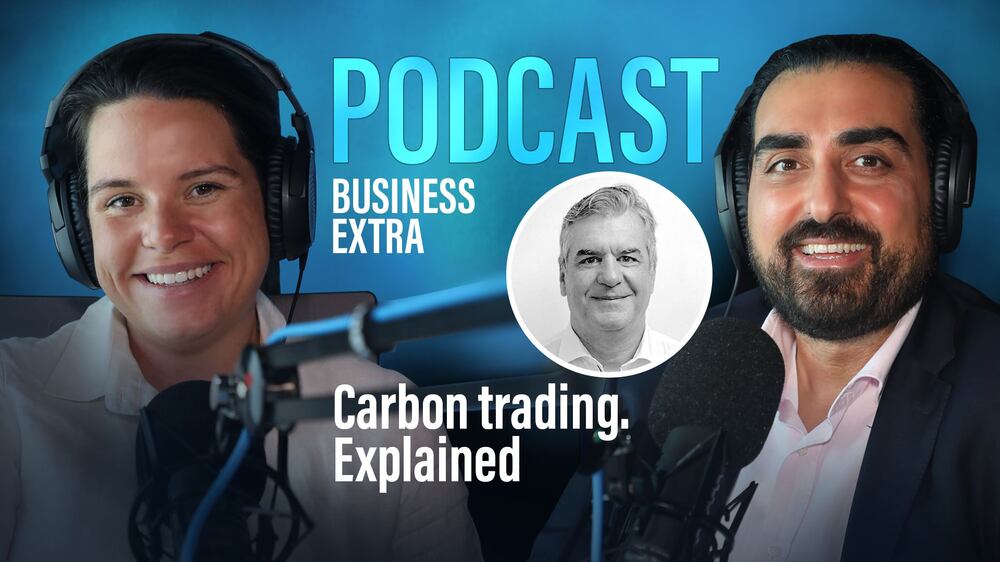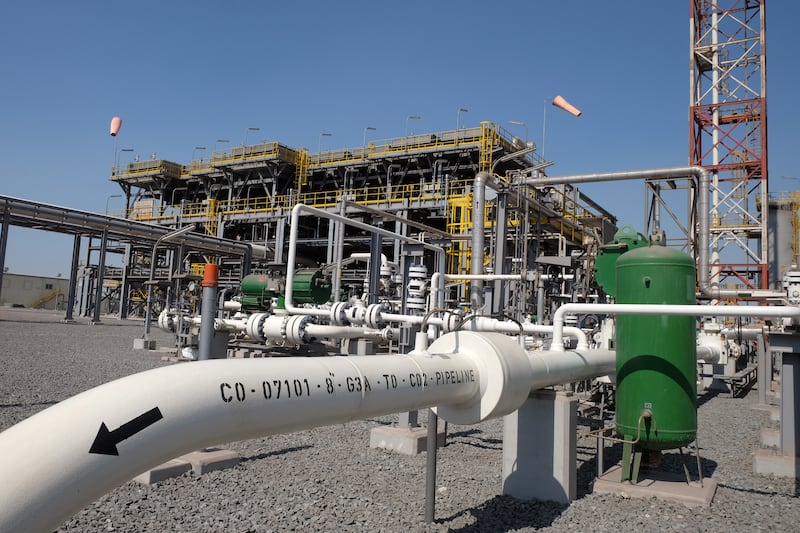Adnoc announced on Wednesday one of the largest carbon capture projects in the Mena region. It will trap 1.5 million tonnes per year of climate-heating carbon dioxide from the Habshan gas processing plant, and store it safely and permanently underground.
This is the second big step the UAE has taken on carbon capture, as it and the region need to go into quick march.
Carbon capture and storage (CCS) deals with carbon dioxide from power stations burning gas, coal, oil or biomass, industrial processes, petroleum operations and cement plants. Instead of releasing it into the atmosphere to heat the globe, carbon dioxide is separated from other gases such as nitrogen and water vapour. It is then transported by pipeline to a suitable storage point, and injected into rock formations several kilometres underground, where it should remain trapped for thousands to millions of years.
Or, the carbon dioxide can be reacted with certain minerals to form solid carbonates, ensuring very permanent storage.
Adnoc started a pilot mineralisation project in Fujairah in January with Oman-based start-up 44.01, whose name refers to the molecular weight of carbon dioxide. The Northern Emirates and Oman host some of the world’s best geology for this approach.
The carbon dioxide can also be re-used to make chemicals, plastics, cements or synthetic fuels, put bubbles in drinks, and enhance growth in greenhouses.
One major use – for enhanced oil recovery – attracts criticism, as producing more oil is seen as undesirable by climate campaigners.
Business Extra: What is a carbon market and how does it address climate change?

But they ignore that this oil would have a much lower – even negative – carbon footprint, and that oil will be produced somewhere in the world to meet demand. If that is not in the UAE, it could be from much higher-carbon or geopolitically problematic suppliers.
Carbon capture is recognised by major energy and climate bodies as essential for decarbonisation goals. Certain industries such as cement, ammonia, waste combustion and iron smelting have almost no technologically-mature, cost-effective alternatives.
But as it is associated with the oil and gas industry, and not familiar the general public like electric cars or rooftop solar panels, it faces unfamiliarity, and opposition from environmental groups who should know better.
Much of the debate about targets for the Cop28 climate conference starting in Dubai on November 30 has revolved around phasing out “fossil fuels” versus “unabated fossil fuels”.
“Abated” fossil fuels are those used with CCS so that emissions to the atmosphere are minimal. The aim should be to eliminate emissions, not prematurely retire fossil fuels – a Sisyphean task on which we are anyway moving far too slowly.
It’s critical for the UAE, therefore, that it demonstrates its serious commitment to CCS ahead of Cop28, and progresses real, large-scale projects.
Adnoc plans to capture 5 million tonnes of carbon dioxide annually by 2030.
In 2016, the world’s first commercial-sized industrial capture project opened at the Emirates Steel plant in Musaffah, with 0.8 million tonnes per year of capture.
In addition to that and the Fujairah and Habshan projects, Adnoc in July announced drilling of the world’s first well for carbon dioxide storage in a carbonate reservoir formation, different from the sandstones used in projects in the North Sea, Canada, Algeria and Australia.
The carbon dioxide comes from fertiliser company Fertiglobe, where capture is essential to produce “blue” or low-carbon ammonia. In 2021, Fertiglobe announced plans for a new blue ammonia facility which, on typical benchmarks, would produce 2.7 million tonnes of carbon dioxide to be captured each year. Past media reports have suggested gas processing from the onshore Shah and offshore Ghasha fields as further targets for CCS.
Last month, Adnoc agreed to evaluate CCS in the UAE and US with American oil company Occidental, a leading proponent. And in July, another UAE player, Sharjah National Oil Company, announced a partnership with Japan’s Sumitomo to develop carbon capture around Sharjah.
So the UAE has a strong and growing portfolio of CCS developments and opportunities. The GCC has, across the UAE, Saudi Arabia and Qatar, about 10 per cent of current global operating capacity. These other countries have their own major ambitions too. These can lift the region’s share of worldwide CCS to about 14 per cent by 2030, depending on how fast other countries progress.
This would be impressive given the growing momentum for CCS in the US and north-western Europe, where carbon prices and tax credits give a strong economic incentive, and governments have finally woken up to the technology’s importance. The UAE’s latest communication on its climate goals mentioned the possible introduction of contracts to pay at least some of the cost of CCS, an important positive step.
Yet the importance of hydrocarbons to the GCC economies, and their geological advantages in storage, mean the region can and should do much more. The energy business is well-accepted here, receiving government approvals is far easier, and storage sites would be in remote desert or offshore locations, raising few safety concerns.
Strategy in Europe has moved from single projects to large hubs which can gather emissions from a wide range of nearby industries and power plants, thus creating economies of scale.
Saudi Aramco plans a 9 million tonne per year hub at the industrial city of Jubail with eventual expansion to 44 million tonnes. GCC countries do not have to limit themselves to cutting their own emissions; they can offer CCS as a service to emitting countries who can’t or won’t store their carbon dioxide at home.
As CCS scales up, the industry gains experience, and new technologies are introduced, costs will come down. Occidental has a long-term vision of itself as a carbon management company. That could be a destination for Adnoc, Aramco and the other Gulf giants too.
Robin M. Mills is chief executive of Qamar Energy and author of The Myth of the Oil Crisis






